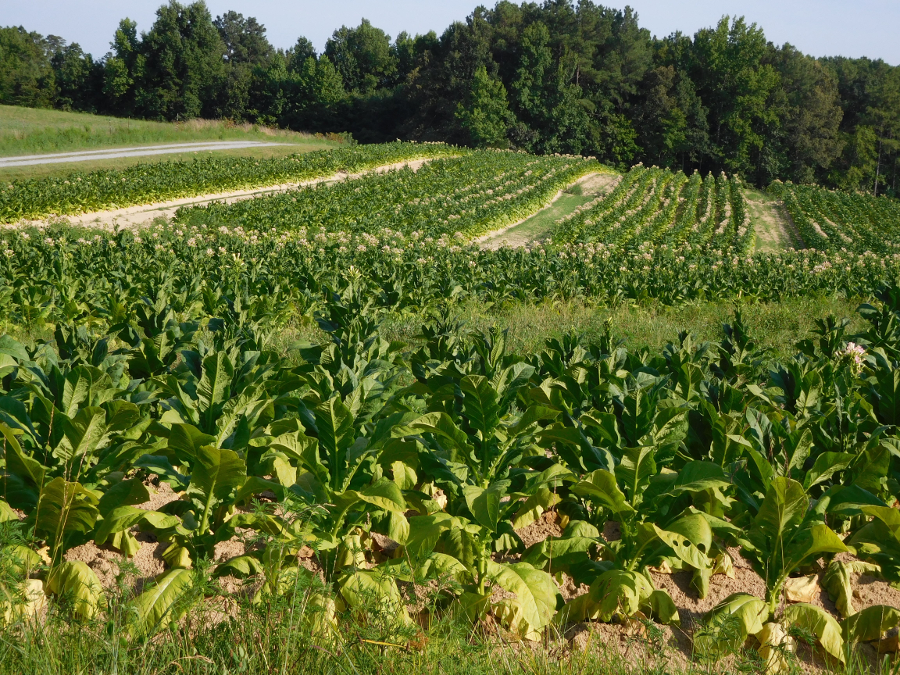
tobacco was grown in Tidewater, the Piedmont, and the Valley and Ridge province west of the Blue Ridge, but modern tobacco farming is concentrated in Southside Virginia

tobacco was grown in Tidewater, the Piedmont, and the Valley and Ridge province west of the Blue Ridge, but modern tobacco farming is concentrated in Southside Virginia
More than any other crop or industry, tobacco shaped the development of Virginia.
Virginia colonists saw the Native Americans growing tobacco, and the colonists quickly adopted tobacco as their primary mechanism of getting wealthy. Virginia operated under "cash-crop" agriculture (tobacco is grown for sale, not for use on the farm) since 1613. Tobacco provided more income than any other farm crop until the 21st Century.
Tobacco plantations shaped the settlement of the Coastal Plain and the Piedmont. Until after World War I the state's economy was dependent upon the weather conditions for growing and harvesting tobacco, and upon the price paid for tobacco by customers outside Virginia.
Staple agriculture puts all of a region's economic eggs in one basket, in contrast to a diversified economy. When prices for the staple crop are low, or supplies diminished by a bad growing season, the entire region can suffer heavily. In the first half of the 1800's, Southern states were dependent upon cotton (though South Carolina grew indigo and rice as staple crops as well). Conflicts with Northern industrialists regarding Federal incentives/disincentives for cotton production led in part to the Civil War, just as conflicts between colonial Virginia planters and English merchants regarding tobacco prices and credit terms created a significant amount of distrust that led to the American Revolution.
In 1613, John Rolfe grew a crop of "sweet-scented" tobacco from seeds that he probably collected while shipwrecked on Bermuda. His seeds were of a species different from the harsh strain of tobacco that was native to Virginia. The colonists discovered that England would pay high prices for the Virginia-grown tobacco, which otherwise had to be imported from Spanish colonies in the Caribbean. A frenzy of tobacco planting followed.
Rolfe's product was popular, but smoking was already popular in Europe before Virginia was colonized. By 1604, James I was so repulsed by the habit that he issued "A Counterblaste to Tobacco" three years before Jamestown was settled.
The Spanish had seen the Aztecs using tobacco a century before Rolfe shipped his crop. Jean Nicot (the French ambassador to Portugal) often is credited with introducing tobacco to France. A monk may actually have been the first to bring it back from Brazil, but Nicot was honored by the botanical name for the species - Nicotiana tabacum.
The Jamestown settlers cared more about the price paid for tobacco than about King James's personal opinion on smoking. The tobacco in Rolfe's original shipment of four hogsheads was sold at 3 shillings per pound. The West Indies crops sold at six times that price - but at 3 shillings a pound, the Virginians had finally identified tobacco as a product they could export at a profit. Exports increased from 2,300 pounds in 1616 to almost 50,000 pounds in 1618.1
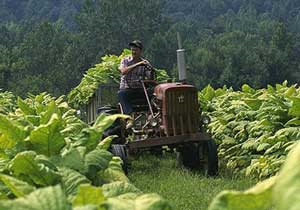
tobacco farms are usually too small to justify the latest equipment
Source: US Department of Agriculture, U.S. Tobacco Industry Responding to New Competitors, New Challenges
The plantation economy in Virginia was based on cheap land and cheap labor. Tobacco is labor-intensive, requiring over a full year of labor to gather the tiny seeds, grow them early in the year in cold frames, transplanting to the outdoor fields when the soil is warm, weeding throughout the summer, "topping" most plants (to remove the flowers and force more of the plant's energy into the leaves), then harvesting the leaves individually for several weeks as they ripen in late Summer-early Fall.
By 1700, it was clear that immigration from Europe and natural increase from local colonists was unable to supply sufficient to work the plantations, as settlement moved into the Piedmont. Virginia created a legal structure for holding black families in permanent slavery in the 20 years between 1667-1686, and imported a huge quantity of slaves after 1700 to provide the labor to grow tobacco.
At the time of the first census in 1790, 40% of the residents in Virginia were slaves. The original English settlements starting with Jamestown had no slaves, of course. The first black slaves arrived in 1619. In 1660 only 3% of the colonists were black, and in 1680 the blacks still composed less than 7% of the population.2
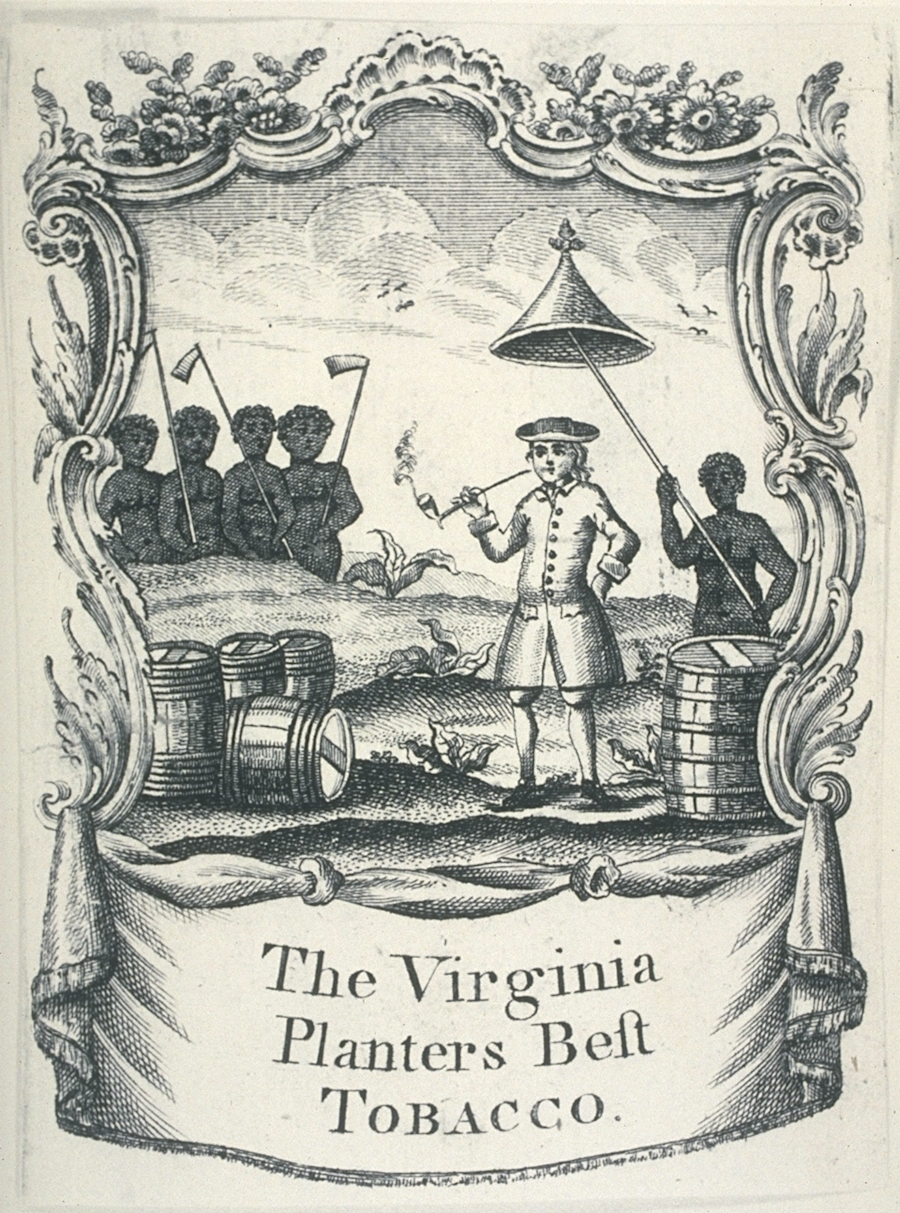
tobacco farming was the economic driver for establishing slavery in Virginia
Source: Slavery Images: A Visual Record of the African Slave Trade and Slave Life in the Early African Diaspora, Tobacco Production, Virginia, 18th cent.
The shift to tobacco as a staple crop triggered the demographic shift in Virginia, as articulated by two scholars of the era:3
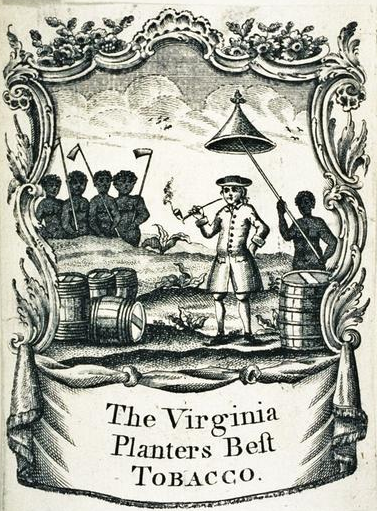
the economic reason for slavery in Virginia was a desire for low-cost labor to grow tobacco
Source: National Park Service, African American Heritage and Ethnography
Intellectually, a "tobacco mentality" affected the wealthy plantation owners in Tidewater. They competed over the quality of their crop, while going deeper and deeper in debt to English merchants to display their wealth and maintain status in colonial society. [After the American Revolution, Patrick Henry questioned why the war had been fought if the Americans were still going to be obliged to pay those debts...]
Initially, tobacco was exported directly to England, France, Holland, the Caribbean Islands, and South America. Virginia provided more revenue to England than any other colony, through a 2 shilling/hogshead export tax on tobacco.
To ensure a higher percentage of the profits were kept in England, Charles II issued the Navigation Acts in 1651. These acts prohibited export of tobacco except to English ports - but enterprising Scottish and Dutch sea captains still traded in the Chesapeake and, at times, evaded the authorities and the export fees. The efforts to control the colonial economy to benefit the merchants in England led, in part, to the American Revolution in 1775.
Originally, John Rolfe and other initial growers in Jamestown piled tobacco leaves and allowed them to "sweat" as they dried out before shipment to England. Virginia farmers soon discovered the advantages of hanging leaves to dry before pressing them into barrels known as hogsheads.
Though planters could obtain insurance for safe delivery of their cargo to buyers in England, they still had to process the leaves and seal the hogsheads tightly so the tobacco inside would not rot or be spoiled by seawater during delivery. The first hogsheads in the mid-1600's weighed 500 pounds, "[b]ut over time the size of the hogshead was increased and the amount of tobacco prized (that's tobacco speak for squeezed) into it increased so that by the Revolution a typical hogshead weighed nearly 1300 pounds."4
Control over tobacco growing, processing, and shipment was always a major topic at meetings of the House of Burgesses. In the 1730's, the House finally acceded to Governor Gooch's efforts to force tobacco to be inspected before shipment.
Before inspection, tobacco could be shipped from any wharf, and the quality of the exported tobacco was unregulated. Exporting poor-quality tobacco depressed prices for everyone, since purchasers were often unable to fully inspect the hogsheads before delivery. Once the inspection warehouses were established at specific locations in Tidewater, it was harder for unscrupulous growers to ship trash tobacco - and easier for colonial officials to collect the appropriate taxes as well.
Virginia planters had little control over the sale of their tobacco crop, until the union between Scotland and England in 1707 led to Scottish merchants opening stores in Virginia's Fall Line cities and Norfolk in the 1730's. Small planters then could sell their crop in Virginia, purchase farm tools, clothing, and other items from the same merchant, and eliminate the risk of shipment and sale overseas.
Large planters continued to ship their hogsheads to England, then trust their crop to agents in London, Bristol, and other cities to sell their tobacco for them. The same agents were instructed to purchase household goods and luxury items for the planters, often before profits were known. Many of the leading Virginia planters went deeply into debt in the 1760's after miscalculating the sales price of their crop, or ordering too many imported goods before discovering the annual tobacco crops produced by their slaves resulted in fewer hogsheads than projected.
George Washington was a "successful" tobacco planter. He inherited slaves and good agricultural lands on the Middle Peninsula and the Peninsula when he married the richest widow in the state, Martha Dandridge Custis. In 1759, his slaves on the Claibornes plantation produced "23,427 pounds of tobacco and 281 barrels of corn."5
However, Washington quit growing tobacco on his Potomac River plantations, in part because the transportation costs from that location were greater and also because he felt the agents were unskilled and/or unfair in their dealings. Despite his instructions to time the sale of his crop to reflect the seasonal high points in the market, Washington received low prices so often that he shifted to raising wheat, oats, and other small grains on his Mount Vernon plantations.
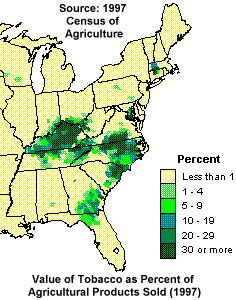 Northern colonies without a staple crop also imported slaves before 1808, when such trade was banned in the United States. However, Northern imports were in far smaller numbers. The social pattern of Virginia reflected the agricultural and economic pattern of the colony. Further south, colonies made an even-greater investment in slave-based agriculture, while the colonies to the North diversified into manufacturing and wheat growing.
Northern colonies without a staple crop also imported slaves before 1808, when such trade was banned in the United States. However, Northern imports were in far smaller numbers. The social pattern of Virginia reflected the agricultural and economic pattern of the colony. Further south, colonies made an even-greater investment in slave-based agriculture, while the colonies to the North diversified into manufacturing and wheat growing.
By the 1850's, Virginia was on the border of two economic systems. When the Southern states seceded to create the Confederacy in 1860-61, Virginia hesitated to join them. North Carolina, Kentucky, Tennessee, Missouri and Arkansas were "Upper South" states along with Virginia, with greater diversity in their economies and tighter economic interdependency with Baltimore, Philadelphia, and New York. The Upper South states stayed in the Union until after shots were fired at Fort Sumter. Kentucky and Missouri never seceded officially, by most accounts, though the Confederacy put a star in its battle flag for both states.
Not all regions of Virginia were tobacco plantation territory from the beginning. Southwestern Virginia farmers converted from self-sufficient agriculture to growing tobacco as a cash crop (with slave labor) only after the Virginia and Tennessee Railroad arrived.
That railroad provided cost-effective transportation connecting the fertile limestone valleys in the Tennessee River drainage to the processing centers at Lynchburg, Petersburg, and Richmond. Before it arrived, it cost too much to carry tobacco across the Eastern Continental Divide to the Atlantic ports. After the railroad, farmers quickly shifted to growing tobacco. When faced with secession in 1861, Southwestern Virginia politicians chose to stay loyal to the leaders in Richmond rather than join the new state of West Virginia, in large part because of economic and social ties that developed in the 1850's as the region adopted tobacco as a cash crop.
1. Collier, Christopher and Collier, James Lincoln, The Paradox of Jamestown, 1585-1700, Marshall Cavendish, New York, 1998, p.55
2. Croghan, Laura A., "'The Negroes to Serve Forever': The Evolution of Blacks's Life and Labor in Seventeenth-Century Virginia," Masters Thesis, William and Mary, 1994, p. 6-7
3. Deetz, James, Flowerdew Hundred: The Archeology of a Virginia Plantation, 1619-1864, p.9, as quoted in Croghan, p. 5; Menard, Russell, "From Servants to Slaves: The Transformation of the Chesapeake Labor System," Southern Studies, XVI (Winter 1977), p.383, as quoted in Croghan, p. 8
4. Peter Bergstrom, Re: early 19th C. packing crates message on VA-HIST listserver, January 28, 2002
5. Henry Wiencek, "A slave's work load," VA-HIST listserver posting, December 14, 2001